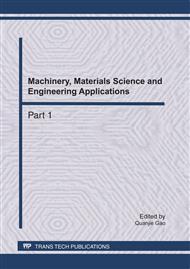p.1107
p.1112
p.1118
p.1125
p.1129
p.1135
p.1143
p.1150
p.1156
Preparation of Metal Cobalt Powder by Co-Precipitation and Heat Decomposition Method
Abstract:
A novel chemical precipitation method was studied to prepare the metal cobalt powder from the precursor Co(OH)x(CO3)y powder. From XRD and IR analysis, it was proved that there were interactions between the NH4+, Cl- and the precursor powder of Co(OH)x(CO3)y. Based on DSC-TGA analysis, the influence of additive and temperature on the cobalt powder preparation process was observed during heat decomposition. The results showed that pure metal cobalt was obtained when the amount of the additive tartaric acid was about 60% and calcination temperature was 500°C.
Info:
Periodical:
Pages:
1129-1134
Citation:
Online since:
April 2011
Authors:
Keywords:
Price:
Сopyright:
© 2011 Trans Tech Publications Ltd. All Rights Reserved
Share:
Citation:


